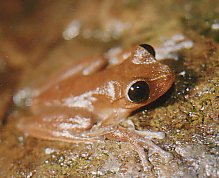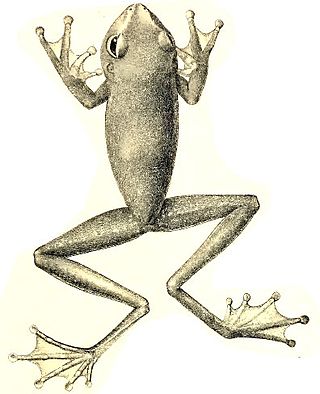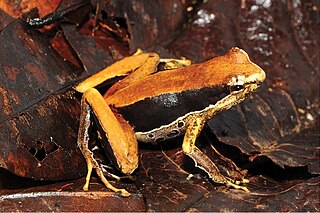
Nyctimystes is a genus of tree frogs in the subfamily Pelodryadinae of the family Hylidae. They are principally Papuan species, but also inhabit islands in the Moluccas. All species in this genus have one distinct feature that separates them from other species in the family, the lower eyelid is marked with pattern of lines, veins, or dots. This feature presumably acts as camouflage when the frogs are at rest during the day.
Nyctimystes daymani, also known as the Dayman big-eyed treefrog, is a species of frog in the subfamily Pelodryadinae. It is endemic to Papua New Guinea and known from its type locality, Mount Dayman in the Milne Bay Province, easternmost mainland New Guinea. Records from further west are uncertain.
Nyctimystes gularis, the Mondo big-eyed tree frog, is a species of frog in the subfamily Pelodryadinae, endemic to Papua New Guinea. Its natural habitats are subtropical or tropical moist montane forests and rivers.
Nyctimystes kubori is a species of frog in the subfamily Pelodryadinae of the family Hylidae. It is endemic to Papua New Guinea and is widespread in the New Guinea Highlands between 141°E and 147°E and in the mountains of the Huon Peninsula. The specific name kubori refers to its type locality in the Kubor Mountains. Common name sandy big-eyed treefrog has been coined for this species.

Nyctimystes montanus is a species of frog in the subfamily Pelodryadinae. It is endemic to the Arfak Mountains, located in the Bird's Head Peninsula of northwestern New Guinea. This species is only known from its type locality. There are no records of this species after it was described in 1878, perhaps because of lack of surveys.
Nyctimystes narinosus, the common big-eyed treefrog, is a species of frog in the subfamily Pelodryadinae of the family Hylidae. It is endemic to New Guinea and occurs in the Wahgi-Sepik Dividing Range and the Schrader Mountains, on both sides of the border between Papua (Indonesia) and Papua New Guinea. There is, however, some uncertainty about the western limit of this species. Despite its vernacular name, Nyctimystes narinosus is not a common species.
Nyctimystes perimetri, also known as the archipelago big-eyed treefrog, is a species of frog in the subfamily Pelodryadinae of the family Hylidae. It is endemic to Papua New Guinea and currently only known from the Louisiade Archipelago, although it might also occur in the Owen Stanley Range of the mainland Papua New Guinea. It has also been suggested that the Rossel Island population might represent a distinct species.
Nyctimystes persimilis, also known as the Milne big-eyed treefrog, is a species of frog in the subfamily Pelodryadinae of the family Hylidae. It is endemic to Papua New Guinea and known from Mount Dayman and Mount Simpson in the Owen Stanley Range.
Nyctimystes trachydermis, also known as the Morobe big-eyed treefrog, is a species of frog in the subfamily Pelodryadinae of the family Hylidae. It is endemic to Papua New Guinea and occurs in the mountains of southern eastern New Guinea. Its type locality is Gapaia Creek, at 1,280 m (4,200 ft) asl between Garaina and Saureli, in the Morobe Province. The specific name trachydermis means "rough skinned", derived from the Greek words trachys and derma.
Nyctimystes tyleri is a species of frog in the subfamily Pelodryadinae of the family Hylidae. It is endemic to Papua New Guinea and only known from its type locality, Gapaia Creek, between Garaina and Saureli, in the Morobe Province. The specific name honours Michael J. Tyler, an Australian herpetologist, "in recognition of his notable contributions to the systematics of Australo-papuan frogs." Common name Tyler's big-eyed treefrog has been coined for this species.

Papurana papua is a species of true frog, family Ranidae. It is endemic to New Guinea and found in the northern part of the island in both Indonesia and Papua New Guinea as well in some offshore islands. Common name Papua frog has been coined for it.
Nyctimystes purpureolatus is a species of frog in the subfamily Pelodryadinae. It is endemic to New Guinea and is known from its type locality on the Tiri River, a small tributary of the Mamberamo River in West Papua, Indonesia, and from three locations in West Sepik Province, Papua New Guinea.
Litoria spartacus is a species of frog in the subfamily Pelodryadinae of the family Hylidae. It is endemic to Papua New Guinea and is only known from two localities within the Kikori Integrate Conservation and Development Project Area in the Southern Highlands Province. It has affinities to Litoria macki and Litoria spinifera but has a smaller size and more extensively webbed hands and less tuberculate body.

Mantophryne insignis is a species of frog in the family Microhylidae. It is endemic to Woodlark Island in the Milne Bay Province of Papua New Guinea. The specific name insignis is Latin meaning "remarkable" or "conspicuous". It refers to the distinctive colour pattern of this frog, as well as to its unusual arboreal lifestyle within predominantly terrestrial genus.
Nyctimystes hunti is a species of tree frog in the subfamily Pelodryadinae. It is endemic to northern Papua New Guinea. Scientists have seen it only in Utai, Sanduan Province, but predict that also lives elsewhere on New Guinea.
Nyctimystes sauroni is a species of tree frog in the subfamily Pelodryadinae. It is endemic to Papua New Guinea. Scientists know it solely from the Kikori Integrate Conservation and Development Project area.
Nyctimystes ocreptus is a species of tree frog in the subfamily Pelodryadinae, endemic to Papua New Guinea. Scientists have observed it on Mount Albert Edward, 2600 meters above sea level. Some may also live on Mount Victoria or Mount Knutsford.
Nyctimystes cryptochrysos is a species of tree frog in the subfamily Pelodryadinae, endemic to Papua New Guinea. It lives on Fergusson Island between 900 and 1500 meters above sea level. Scientists suspect it may also live in the D'Entrecasteaux Islands.
Nyctimystes calcaratus is a species of frog in the subfamily Pelodryadinae, endemic to New Guinea. Scientists observed it about 1230 meters above sea level near a forest stream.
Nyctimystes latratus is a species of tree frog in the subfamily Pelodryadinae endemic to Papua New Guinea. Scientists have seen it between 500 and 1200 meters above sea level on Mount Dayman and near the Bai-u River.




